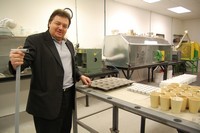 Business is heating up for SPJ Labs, Sudbury’s new fire assay laboratory.
Business is heating up for SPJ Labs, Sudbury’s new fire assay laboratory.
The doors officially opened for business March 12th to interested clients seeking fire assay work for their precious metals.
Fire assaying, a sample preparation technique, is an ancient method of extracting precious metals using heat. Sometimes described as an "art," the technique has been around since the time of the Phoenicians and is known to be one of the most reliable methods for determining the amount of gold, silver and platinum group metals from an ore sample.
Co-owned by Jeff Fuller, Peter Larabie and Sav Dagostino, the lab is located at the Fuller Industrial site. Both Larabie and Dagostino, who are on the cusp of retirement, have pooled their resources and expertise to set up and run the business.
Dagostino has more than 30 years of lab sample preparation experience earned at Vale Inco. He calls this new endeavour a "labour of love."
Larabie, senior analyst, boasts more than 30 years of experience working in government labs. He spent 18 years as a bullion processor working for Temiskaming Testing Laboratories and is presently a fire assay technician for the Ministry of Northern Development and Mines’ Geoscience Laboratories.
The two entrepreneurs made the decision to open a lab more than a year ago when the markets were soaring and there was a global demand for assay work. Despite ailing base-metal markets, precious metals are doing well and there is still a strong demand for fire assaying.
Larabie said there are few fire assay labs remaining because about 15 years ago, the trend was to use chemicals. Fire assaying is 100 per cent accurate and takes the product back to a slag, removing hazardous material that is contained and recycled.
"There is no other private fire assay lab in Sudbury that does what we do," Larabie said.
SPJ Labs does gold, silver and lead fire assaying with a silver collection. Presently, they can average 200 samples per day, or 1,000 samples weekly. They describe it as a "good turn-around time." As business increases, they plan to hire more lab technicians.
Hands on
SPJ Labs uses a "hands-on" as opposed to a robotic technique. Larabie said hands-on is preferable because it allows them to deal with every sample separately and to make the proper flux adjustments necessary to achieve complete removal of all precious metals. Hands-on is a more desirable method because most of the samples they deal with are complex.
A sister company will be performing the chemistry part of the analyses using Induction Coupled Plasma (ICP) and Atomic Absorption, another stage of analysis.
Duplicate samples, in-house standards as well as international standards are used for quality assurance purposes. Spot checks are done on all consumables such as flux and acid to ensure no contamination. The company is also in the process of applying for ISO 9000-certification.
Process
Fire assaying is still the most generally accepted method of analysis for gold and platinum group elements. The basic technique involves adding a flux, as well as lead and silver to the gold sample. The addition of heat causes a fusion where the silver acts as a collector for the gold and other precious metals that are present. Larabie describes it as a process of elimination.
When samples are first received, they are dried in a dryer oven, then crushed in a jaw crusher, and placed into a splitter until 250 grams of sample is retrieved. The remainder is returned to the bag as a reserve. A pulverizing system reduces the sample to a powder approximately 80 mesh (80 holes per square inch).
A lead flux comprised of soda ash, borax, flour, silica and lead oxide, along with other needed reagents, is added to the sample to remove impurities. Placed in a fire clay crucible, the sample is put into a fusion furnace at 2,000 degrees Fahrenheit for an hour. At high temperatures, the flux dissolves the sample, causing the lead to reform into a metal, which picks up the precious metals as they sink to the bottom of the crucible. The waste rock, known as gangue or slag, sits on top of the lead.
The molten sample is then poured into iron molds. Once cooled, the gangue is broken away and the lead button containing the precious metals is cleaned and ready for a procedure known as cupellation.
During this process the lead button is placed onto a heated cupel made of bone ash or magnesium oxide. The cupels are placed into the furnaces where they absorb the lead and any trace amounts of base metals. Left behind is a silver prill containing all the precious metals. This is the first stage of fire assaying.
The process of anneiling dissolves the silver bead in nitric acid, which leaves the gold to be weighed gravimetrically. The platinum group metals are dissolved with aqua regia (a powerful acid) and run on ICP units at a sister lab.
A $250,000 investment has furnished the lab with three fusion furnaces, a fourth oven for drying samples, work stations, appropriate fans and ventilation systems, and various other tools of the trade.
Although their location at Fuller Industrial is short-term, Dagostino and Larabie said as business increases, their plans are to go larger and include an ICP lab on the premises as well.
As of early April, they had already performed sample work for companies in Kirkland Lake, Timmins, and British Columbia. With more than 500 gold and exploration companies in Ontario, SPJ Labs plans to focus on the local market, but is open for business to anyone seeking their services.


